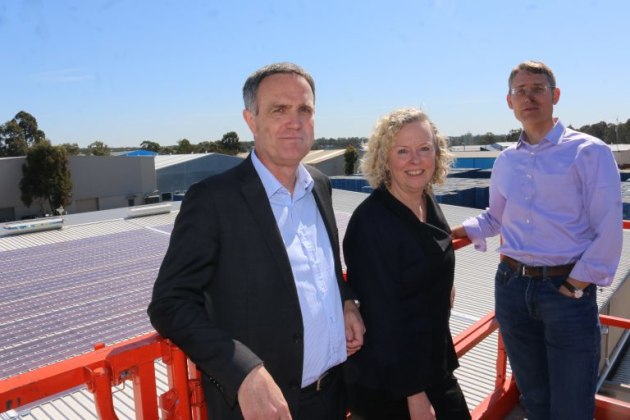The first commercial installation of printed organic solar cells, at CHEP’s Beresfield facility near Newcastle, highlights the wealth of opportunities functional printing has to offer the printing industry, says University of Newcastle’s Professor Paul Dastoor.
At a ribbon-cutting ceremony at CHEP’s pallet repair facility at Beresfield on Thursday, Phillip Austin, president of CHEP Asia-Pacific, hailed the installation as a landmark collaboration between science and commercial enterprise. “A chance as a business to be able to make a difference with energy, to increase access and availability to draw it from the right sources, and to reduce costs – why wouldn’t we want to get involved?” he told Print21.
Five PhD students from the University of Newcastle’s Newcastle Institute for Energy and Resources (NIER) installed 200 square metres of solar cells, printed onto strips of PET plastic as thin as a packet of chips, on the roof of the plant in the space of 12 hours.
According to Dastoor, the ink, which has the same electronic properties as silicon, is a significant breakthrough. “Most people are familiar with standard silicon solar cells – they’re hard, they’re rigid, they’re covered in glass. What we have here is a set of polymeric materials with the same electronic behaviours as silicon that can be turned into a liquid solution for printable paints and inks,” he said. “We’re replacing conventional hard inorganic semiconductors with flexible organic semiconducting materials.”
The lightweight solar cells, which were exhibited at PacPrint last year, can be produced at a cost of less than $10 per square metre on standard narrow web presses, and secured with ordinary double-sided tape. “You don’t need specialised equipment – we used a conventional reel-to-reel press, supplied by GM, that is normally used to make wine labels.”

The inks can be printed using standard flexo, screen and spot dye processes, and NIER is collaborating with Fuji Xerox on inkjet. According to Dastoor, the opportunities for commercial printers in this space, dubbed functional printing, are huge. “There is enormous potential, and it doesn’t just stop at solar panels,” he said. “We’re able to print structures that have electronic function.
“We have an enormous project looking at building biosensors – this same printing can be used to print transistors in which we can embed bio-molecules, and we’re now working on sensors for glucose that will test your saliva rather than your blood. There are 440 million people with diabetes, and they have to stab themselves six to ten times per day. Imagine if instead they could simply lick a printed sensor.”
Dastoor plans to test the performance and durability of the printed cells, then recycle them into new cells at the end of their lifespan.






